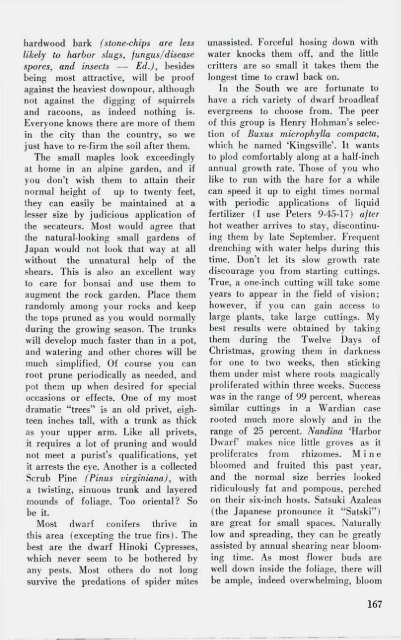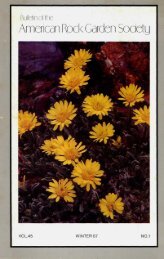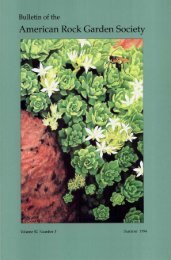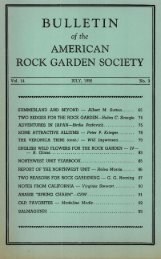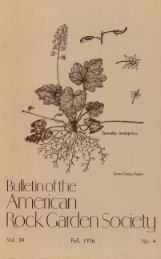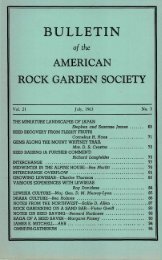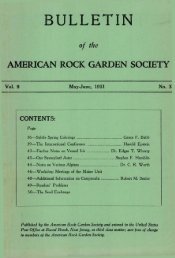Bulletin - Fall 1979 - North American Rock Garden Society
Bulletin - Fall 1979 - North American Rock Garden Society
Bulletin - Fall 1979 - North American Rock Garden Society
You also want an ePaper? Increase the reach of your titles
YUMPU automatically turns print PDFs into web optimized ePapers that Google loves.
hardwood bark (stone-chips are lesslikely to harbor slugs,, fungus/diseasespores, and insects -—- Ed.), besidesbeing most attractive, will be proofagainst the heaviest downpour, althoughnot against the digging of squirrelsand racoons, as indeed nothing is.Everyone knows there are more of themin the city than the country, so wejust have to re-firm the soil after them.The small maples look exceedinglyat home in an alpine garden, and ifyou don't wish them to attain theirnormal height of up to twenty feet,they can easily be maintained at alesser size by judicious application ofthe secateurs. Most would agree thatthe natural-looking small gardens ofJapan would not look that way at allwithout the unnatural help of theshears. This is also an excellent wayto care for bonsai and use them toaugment the rock garden. Place themrandomly among your rocks and keepthe tops pruned as you would normallyduring the growing season. The trunkswill develop much faster than in a pot,and watering and other chores will bemuch simplified. Of course you canroot prune periodically as needed, andpot them up when desired for specialoccasions or effects. One of my mostdramatic "trees" is an old privet, eighteeninches tall, with a trunk as thickas your upper arm. Like all privets,it requires a lot of pruning and wouldnot meet a purist's qualifications, yetit arrests the eye. Another is a collectedScrub Pine (Pinus virginiana), witha twisting, sinuous trunk and layeredmounds of foliage. Too oriental? Sobe it.Most dwarf conifers thrive inthis area (excepting the true firs). Thebest are the dwarf Hinoki Cypresses,which never seem to be bothered byany pests. Most others do not longsurvive the predations of spider mitesunassisted. Forceful hosing down withwater knocks them off, and the littlecritters are so small it takes them thelongest time to crawl back on.In the South we are fortunate tohave a rich variety of dwarf broadleafevergreens to choose from. The peerof this group is Henry Hohman's selectionof Buxus microphylla compacta,which he named 'Kingsville'. It wantsto plod comfortably along at a half-inchannual growth rate. Those of you wholike to run with the hare for a whilecan speed it up to eight times normalwith periodic applications of liquidfertilizer (I use Peters 9-45-17) afterhot weather arrives to stay, discontinuingthem by late September. Frequentdrenching with water helps during thistime. Don't let its slow growth ratediscourage you from starting cuttings.True, a one-inch cutting will take someyears to appear in the field of vision;however, if you can gain access tolarge plants, take large cuttings. Mybest results were obtained by takingthem during the Twelve Days ofChristmas, growing them in darknessfor one to two weeks, then stickingthem under mist where roots magicallyproliferated within three weeks. Successwas in the range of 99 percent, whereassimilar cuttings in a Wardian caserooted much more slowly and in therange of 25 percent. Nandina 'HarborDwarf makes nice little groves as itproliferates from rhizomes. Minebloomed and fruited this past year,and the normal size berries lookedridiculously fat and pompous, perchedon their six-inch hosts. Satsuki Azaleas(the Japanese pronounce it "Satski")are great for small spaces. Naturallylow and spreading, they can be greatlyassisted by annual shearing near bloomingtime. As most flower buds arewell down inside the foliage, there willbe ample, indeed overwhelming, bloom167


